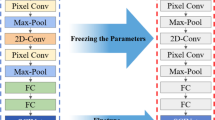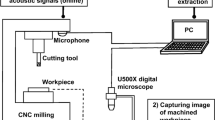Abstract
Deep learning has gained popularity in the task of tool wear identification recently. As an important application of deep learning, however, there exists few public datasets and benchmarks for the research of visual identification of tool wear. To address this issue, we present a classification-based image dataset for carbide milling tool wear (NJUST-CCTD) and make it publicly available on the Github website. This dataset includes two categories: wear tools and no-wear tools. The two categories contain 5000 and 3000 photos, respectively. Based on this dataset, eight baselines are evaluated as references against this benchmark. To further improve the classification performance, we propose a novel cemented carbide milling tool wear intelligent classification framework (CMCNet). The framework consists of two modules: a deep learning based classification network and a multi-scale feature fusion based denoising network called DSSNet. DSSNet is constructed with deeper network structure, connections across layers, and multi-scale sequence fusion module. It is capable of explicitly modeling the semantic and spatial correlation. Apart from DSSNet, the denoising module further improves the performance by adaptively altering the level of denoising based on the performance of the network. The two modules could be optimized with the backward gradient, yielding an end-to-end learning framework. On the basis of the dataset, CMCNet performed exceptionally well when categorizing photos intelligently. After 50 training epochs, the model outperformed the original classification network by 3.250%, achieving the top-1 accuracy of 95.375% on the test set. The NJUST-CCTD can be downloaded at https://github.com/paddy112233/PADDY.








Similar content being viewed by others
Availability of data and materials
The NJUST-CCTD is available from the Github website The parameters of the milling tools and acquisition systems are listed in Tables and figures.
Code availability
The algorithm (code) designed for the framework is clearly expressed in the flow chart.
Notes
MMClassification is an open source classification toolbox based on PyTorch.
References
Qiang L, Ya-dong G, Ming C, Ming-jun L (2017) Research on surface integrity in milling inconel718 superalloy. The International Journal of Advanced Manufacturing Technology 92(1):1449–1463
Chen N, Hao B, Guo Y, Li L, Khan MA, He N (2020) Research on tool wear monitoring in drilling process based on apso-ls-svm approach. The International Journal of Advanced Manufacturing Technology 108(7):2091–2101
Jeon J, Kim S-W (1988) Optical flank wear monitoring of cutting tools by image processing. Wear 127(2):207–217
Kim J-H, Moon D-K, Lee D-W, Kim J-S, Kang M-C, Kim KH (2002) Tool wear measuring technique on the machine using ccd and exclusive jig. Journal of materials processing technology 130:668–674
García-Ordás MT, Alegre E, González-Castro V, Alaiz-Rodríguez R (2017) A computer vision approach to analyze and classify tool wear level in milling processes using shape descriptors and machine learning techniques. The International Journal of Advanced Manufacturing Technology 90(5):1947–1961
Sortino M (2003) Application of statistical filtering for optical detection of tool wear. International Journal of Machine Tools and Manufacture 43(5):493–497
Bhat NN, Dutta S, Pal SK, Pal S (2016) Tool condition classification in turning process using hidden markov model based on texture analysis of machined surface images. Measurement 90:500–509
Dutta S, Pal SK, Sen R (2016) On-machine tool prediction of flank wear from machined surface images using texture analyses and support vector regression. Precision Engineering 43:34–42
Li L, An Q (2016) An in-depth study of tool wear monitoring technique based on image segmentation and texture analysis. Measurement 79:44–52
Mikołajczyk T, Nowicki K, Kłodowski A, Pimenov DY (2017) Neural network approach for automatic image analysis of cutting edge wear. Mechanical Systems and Signal Processing 88:100–110
García-Ordás MT, Alegre-Gutiérrez E, Alaiz-Rodríguez R, González-Castro V (2018) Tool wear monitoring using an online, automatic and low cost system based on local texture. Mechanical systems and signal processing 112:98–112
Weimer D, Scholz-Reiter B, Shpitalni M (2016) Design of deep convolutional neural network architectures for automated feature extraction in industrial inspection. CIRP annals 65(1):417–420
Terrazas G, Martínez-Arellano G, Benardos P, Ratchev S (2018) Online tool wear classification during dry machining using real time cutting force measurements and a cnn approach. Journal of Manufacturing and Materials Processing 2(4):72
Wu X, Liu Y, Zhou X, Mou A (2019) Automatic identification of tool wear based on convolutional neural network in face milling process. Sensors 19(18):3817
Ambadekar P, Choudhari C (2020) Cnn based tool monitoring system to predict life of cutting tool. SN Applied Sciences 2(5):1–11
Bergs T, Holst C, Gupta P, Augspurger T (2020) Digital image processing with deep learning for automated cutting tool wear detection. Procedia Manufacturing 48:947–958
Brili N, Ficko M, Klančnik S (2021) Automatic identification of tool wear based on thermography and a convolutional neural network during the turning process. Sensors 21(5):1917
Kumar MP, Dutta S, Murmu N (2021) Tool wear classification based on machined surface images using convolution neural networks. Sādhanā 46(3):1–12
Banda, T., Jie, B.Y.W., Farid, A.A., Lim, C.S.: Machine vision and convolutional neural networks for tool wear identification and classification, pp. 737–747. Springer, Singapore (2022)
Boyat, A.K., Joshi, B.K.: A review paper: noise models in digital image processing. arXiv preprint arXiv:1505.03489 (2015)
Zuiderveld, K.: Contrast limited adaptive histogram equalization. Graphics gems, 474–485 (1994)
Li Y, Mou W, Li J, Liu C, Gao J (2021) An automatic and accurate method for tool wear inspection using grayscale image probability algorithm based on bayesian inference. Robotics and Computer-Integrated Manufacturing 68:102079
Semenishchev, E., Voronin, V., Zelensky, A., Alepko, A., Zhdanova, M., Agaian, S.: Determination of tool cutting surface quality from analysis on a group of images and the combined data. In: Multimodal Image Exploitation and Learning 2021, vol. 11734, pp. 71–78 (2021). SPIE
Wei W, Yin J, Zhang J, Zhang H, Lu Z (2021) Wear and breakage detection of integral spiral end milling cutters based on machine vision. Materials 14(19):5690
Cheng, X., Yu, J.: Monitoring method for machining tool wear based on machine vision. Journal of ZheJiang University(Engineering Science) 55(5), 896–904 (2021)
Z, C., Jin, J., Chen, C.: Research on tool wear monitoring based on gru-cnn. In: 2021 6th International Conference on Intelligent Computing and Signal Processing (ICSP), pp. 729–733 (2021). IEEE
Wu, Q., Zhou, X., Pan, X.: Cutting tool wear monitoring in milling processes by integrating deep residual convolution network and gated recurrent unit with an attention mechanism. Proceedings of the Institution of Mechanical Engineers, Part B: Journal of Engineering Manufacture, 09544054221124476 (2022)
Xie Y, Zhang C, Liu Q (2020) Tool wear status recognition and prediction model of milling cutter based on deep learning. IEEE Access 9:1616–1625
National Aeronautics and Space Administration: PCoE Milling Data sets[EB/POL]. https://ti.arc.nasa.gov/tech/dash/groups/pcoe/prognostic-data-repository/; Experiments on a milling machine for different speeds, feeds, and depth of cut.Records the wear of the milling insert, VB. The data set was provided by the BEST lab at UC Berkeley., Last accessed on 2022-6-30 (2017)
PHM Society Conference Data Challenge[EB/OL]: PHM Tool wear Data sets[EB/OL]. https://phmsociety.org/phm_competition/2010-phm-society-conference-data-challenge/, Last accessed on 2022-6-30 (2010)
Lutz, B., Kisskalt, D., Regulin, D., Reisch, R., Schiffler, A., Franke, J.: Evaluation of deep learning for semantic image segmentation in tool condition monitoring. In: 2019 18th IEEE International Conference on Machine Learning and Applications (ICMLA), pp. 2008–2013 (2019). IEEE
Lutz B, Reisch R, Kisskalt D, Avci B, Regulin D, Knoll A, Franke J (2020) Benchmark of automated machine learning with state-of-the-art image segmentation algorithms for tool condition monitoring. Procedia Manufacturing 51:215–221
Ronneberger, O., Fischer, P., Brox, T.: U-net: Convolutional networks for biomedical image segmentation. In: International Conference on Medical Image Computing and Computer-assisted Intervention, pp. 234–241 (2015). Springer
Deng, J., Dong, W., Socher, R., Li, L.-J., Li, K., Fei-Fei, L.: Imagenet: A large-scale hierarchical image database. In: 2009 IEEE Conference on Computer Vision and Pattern Recognition, pp. 248–255 (2009). Ieee
Simonyan, K., Zisserman, A.: Very deep convolutional networks for large-scale image recognition. arXiv preprint arXiv:1409.1556 (2014)
He, K., Zhang, X., Ren, S., Sun, J.: Deep residual learning for image recognition. In: Proceedings of the IEEE Conference on Computer Vision and Pattern Recognition, pp. 770–778 (2016)
Xie, S., Girshick, R., Dollár, P., Tu, Z., He, K.: Aggregated residual transformations for deep neural networks. In: Proceedings of the IEEE Conference on Computer Vision and Pattern Recognition, pp. 1492–1500 (2017)
Zhang, X., Zhou, X., Lin, M., Sun, J.: Shufflenet: An extremely efficient convolutional neural network for mobile devices. In: Proceedings of the IEEE Conference on Computer Vision and Pattern Recognition, pp. 6848–6856 (2018)
Sandler, M., Howard, A., Zhu, M., Zhmoginov, A., Chen, L.-C.: Mobilenetv2: Inverted residuals and linear bottlenecks. In: Proceedings of the IEEE Conference on Computer Vision and Pattern Recognition, pp. 4510–4520 (2018)
Hu, J., Shen, L., Sun, G.: Squeeze-and-excitation networks. In: Proceedings of the IEEE Conference on Computer Vision and Pattern Recognition, pp. 7132–7141 (2018)
Sun, K., Xiao, B., Liu, D., Wang, J.: Deep high-resolution representation learning for human pose estimation. In: Proceedings of the IEEE/CVF Conference on Computer Vision and Pattern Recognition, pp. 5693–5703 (2019)
Tolstikhin IO, Houlsby N, Kolesnikov A, Beyer L, Zhai X, Unterthiner T, Yung J, Steiner A, Keysers D, Uszkoreit J et al (2021) Mlp-mixer: An all-mlp architecture for vision. Advances in Neural Information Processing Systems 34:24261–24272
Zhang K, Zuo W, Chen Y, Meng D, Zhang L (2017) Beyond a gaussian denoiser: Residual learning of deep cnn for image denoising. IEEE Transactions on image Processing 26(7):3142–3155
Zhang K, Zuo W, Zhang L (2018) Ffdnet: Toward a fast and flexible solution for cnn-based image denoising. IEEE Transactions on Image Processing 27(9):4608–4622
MMClassification Contributors: OpenMMLab’s Image Classification Toolbox and Benchmark(Version 0.15.0). https://github.com/open-mmlab/mmclassification, Last accessed on 2022-6-30 (2020)
Wang Z, Bovik AC, Sheikh HR, Simoncelli EP (2004) Image quality assessment: from error visibility to structural similarity. IEEE Transactions on Image Processing 13(4):600–612
Acknowledgements
The authors would also like to thank professor Shiming Xiang, Dr. Xin Zhang and Dr. Xinbang Zhang for their diligent advice in terms of essay writing, as well as General Manager Guoqiang Guo for the wear milling tools from Shanghai Spaceflight Precision Machinery Institute.
Funding
This study was supported by the National Key Research and Development Program of China (2021YFB2012104), National Natural Science Foundation of China (52075267, 52005332).
Author information
Authors and Affiliations
Contributions
Yi Pan, Guoda Xu, Zhe Xiong, Bowen Hu and Yulin Wang have generated the new research idea, designed methodology, done investigations, and conducted experiments; Yi Pan, Guoda Xu and Bowen Hu have established the dataset; Yi Pan, Yuxin Sun, Fengjiao Li and Chunhong Pan have designed algorithms and network frameworks. All authors have actively participated in the revision and approved the manuscript.
Corresponding author
Ethics declarations
Conflict of interest/Conflict of interest
The authors declare no competing interests.
Additional information
Publisher's Note
Springer Nature remains neutral with regard to jurisdictional claims in published maps and institutional affiliations.
Rights and permissions
Springer Nature or its licensor (e.g. a society or other partner) holds exclusive rights to this article under a publishing agreement with the author(s) or other rightsholder(s); author self-archiving of the accepted manuscript version of this article is solely governed by the terms of such publishing agreement and applicable law.
About this article
Cite this article
Pan, Y., Xu, G., Xiong, Z. et al. NJUST-CCTD: An Image Database for Milling Tool Wear Classification with Deep Learning. Int J Adv Manuf Technol 127, 3681–3698 (2023). https://doi.org/10.1007/s00170-023-11418-w
Received:
Accepted:
Published:
Issue Date:
DOI: https://doi.org/10.1007/s00170-023-11418-w




